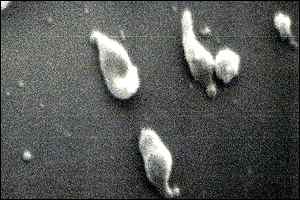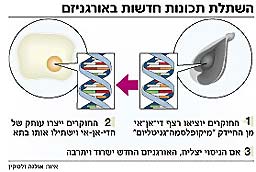Ambition to create a semi-artificial organism with new properties * Genome researcher and Nobel Prize winner will build an organism containing only the most basic genes to live. The government gave them 3 million dollars

M. genitalium: bacterium with the smallest number of genes
A scientist who helped crack the human genome and a Nobel Prize winner announced this evening (Thursday, 21/11/2002) a plan to create new life in the laboratory, using a technique that will raise difficult ethical questions and, on the side, fear of creating a new biological weapon. Scientists Craig Venter and Hamilton Smith hope to produce a single-celled organism that will carry the minimum possible number of genes that make life possible. The researchers received a $3 million grant from the US Department of Energy.
If the experiment is successful, the microscopic cell will feed itself and begin to divide, creating a population of cells that has never been seen before. The experiment is based on a previous experiment conducted about three years ago, in which all the genes that are not necessary for it to live were removed from a bacterium called Myoplasma genitalium. At the end of the process, the bacterium had only 256 genes left. Theoretically, this gene sequence can be reproduced artificially, and inserted into another cell that is also created artificially.
The purpose of the experiment is to create a computer model of the biology of the new organism. Since all organisms are based on the same chemistry, this may shed new light on the entire field of biology. "We wonder if we will be able to find a molecular definition of life," Venter told the Washington Post newspaper.
The newspaper reports that the two scientists are aware that the project may form the basis for the creation of a new biological weapon and that they must be very selective when publishing the details of the experiment. Scientists don't usually announce their experiments in advance, but Venter said he feels that this experiment should be brought to the attention of decision makers in Washington, as it could lay the groundwork for the creation of biological weapons, which could end up in the wrong hands.
The scientists added that the cells would not be able to harm humans and that they would die as soon as they left the protected environment of the laboratory. According to the two, they will delete the gene which gives the bacterium myoplasma genitalium the ability to infect human cells. In the end, they said, it will be a living creature that can only exist in a test tube, under ideal conditions for it.
Smith won the Nobel Prize in 1978 in the field of physiology and medicine. Venter gained publicity after supporting the discovery of a new method that speeds up the identification of genes.
22.11.2002
By: Tamara Traubman
Direct link to this page: https://www.hayadan.org.il/newlife2.html

Two American scientists, one of the leaders in genome research, announced yesterday that they are trying to create a new life form in a laboratory dish. According to them, the project they recently started working on has the potential to gain more knowledge about the basic mechanisms that drive life, but it also raises moral questions.
The researchers aim to create an organism that will be made of a single cell, partly natural and partly man-made, and contain the minimum number of genes necessary to sustain life. In the event that the experiment is successful, the cell will collect nutrition from its environment, multiply and create a new population of cells - which, according to the scientists, "is unlike anything we have known so far."
The project is headed by Prof. Hamilton Smith, Nobel laureate in medicine and an expert in molecular genetics, and Dr. Craig Venter, former president of the American genomics company Celera. The company competed in the public project to decipher the human genome, and published a draft of the contents of the human genome about two years ago. Currently Venter is involved in several new ventures, including the "Institute for Biological Energy Alternatives" - the body where the new project will be conducted.
Recently, the US Department of Energy granted three million dollars for the project, for a period of three years; However, in a statement published by the institute, Venter estimated that the research may take longer. The project will begin as a scientific task, but eventually its findings may also have practical applications. According to Venter, he would like to create a minimalist organism and then try to add different properties to it: for example, giving it the ability to break down carbon dioxide gas emitted from factories or produce hydrogen to be used for fuels. In July, scientists reported the creation of an artificial polio virus, which like other viruses needs a host to survive. In contrast, the cell of Venter and his colleagues will be able to live independently.
The ability to artificially create a living cell in all its components is not close to being realized. However, towards the end of the 90s, Prof. Clyde Hutchinson from the University of North Carolina took an alternative approach to achieve a similar goal. He took one of the simplest bacteria - Mycoplasma genitalium - and tried to identify the minimum number of genes it needed to stay alive. In 1999 he reported that only 265 of its 517 genes are sufficient for the existence of the bacterium, and that this collection of genes can be seen as the minimum set of genes necessary for existence.
The scientists intend to artificially create the 265 genes and assemble a chromosome from them. The chromosome will then be inserted into a natural cell that has been emptied of its genetic content. The artificial genes are supposed to integrate into the cell nucleus. According to Venter, the real test that will determine if the cell is indeed alive will be if the cell replicates itself and reproduces naturally.
According to Venter, the near-term plan is to "understand every imaginable aspect of the organism's biology - an operation that science has never come close to achieving." Since all living cells are based on the same chemical structure and are remarkably similar, this may provide new information about the biology of living things. "We wonder if we can formulate a chemical definition of life," Venter said. "The goal is to thoroughly understand the components of most existing basic cells."
"This is another step in the consequences of genetic engineering, which to a certain extent was expected," said Prof. Hermona Sorek, an expert in molecular biology from the Hebrew University, in response to the study. "At first they created a synthetic gene, then a synthetic protein. Later they created yeast chromosomes with parts taken from humans. The last remaining step is to synthesize genomic information that can replicate itself. It's very ambitious."
In most cases, scientists do not usually report their experiments in advance, but wait until the results are received. But Venter and his team decided to act differently. "I felt that this should be brought to the public's attention and allow a public discussion," he said.
The news of the planned study reignited a debate that began in the US after the events of September 11. The anxiety that gripped the American public led some scientists and politicians to call for restrictions on scientific publications. This, for fear that the information will help countries hostile to the US to develop a new and powerful biological weapon.
Venter and Smith said that genes that allow the artificial cell to attach to human cells will be eliminated, and that the creature that will be obtained, if it is indeed obtained, will be a delicate creature capable of living only in the nutritious and warm environment of the laboratory dish. Before starting the study, Smith and Venter appointed a panel of experts to discuss the ethical aspects of the experiment. The team - which consisted of bioethicists, researchers, a rabbi and a priest - came to the conclusion that there is no obstacle to carrying out the research. However, philosophical and moral questions arise from the discussion of the issue. One of the questions that will arise is, if it turns out that a man-made organism is able to survive and reproduce only in a limited range of laboratory conditions, if it can really be considered "life". Another question, which also arises in other genetic engineering experiments, is whether scientists have a moral right to create a new organism.
For news on this topic at the BBC
The World of Bacteria course of the Open University - links page

4 תגובות
Evolution is already a fact
Myoplasma => Mycoplasma
In my opinion dear, on the contrary, your church will have to accept evolution as a fact, as it accepted cosmology - that the earth revolves around the sun and not the other way around.
It's just a shame it will take another 150 years
One day they will understand, the theory of evolution is a lie and a lie.